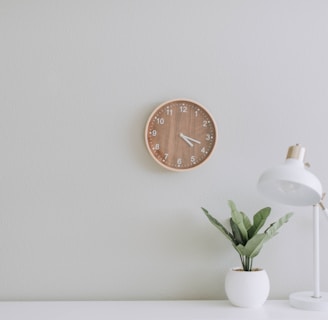Simplicity in Style: Minimalism in Modern Wall Art [2-2]
Explore the rise of minimalism in modern wall art and the methods and styles used by artists to create these popular pieces.
7/20/20235 min read


Minimalist Techniques Used in Modern Wall Art
Minimalism in art is all about simplifying and refining the artwork. In modern wall art, minimalist techniques result in serene, calming compositions that can enhance any interior design. There are several techniques used by modern artists to achieve minimalistic effects, including negative space, monochromatic colors, and simplified forms.
# Negative Space
Negative space refers to the empty or blank area surrounding a design or object within an artwork. The use of negative space is effective in creating balance and emphasizing the subject matter.
Modern artists have been utilizing negative space to create minimalistic designs that leave a lasting impression on viewers. By using empty spaces around a subject matter, artists allow viewers to focus on what's important and truly appreciate the beauty of simplicity.
# Monochromatic Colors
Monochromatic colors refer to a single color palette where different hues and tints of one color are used throughout an artwork. This technique is popular among modern artists who want to keep their artworks simple yet striking. For instance, using shades of gray or black can create a sense of elegance and sophistication while maintaining simplicity.
# Simplified Forms
Simplified forms refer to the use of basic shapes such as circles, squares, triangles, or rectangles within an artwork. Modern artists who aim for minimalism often utilize simplified forms because they allow for easier comprehension by viewers while still suggesting a deeper meaning behind them. Shapes such as circles can suggest completeness while rectangles can imply stability or structure.
Minimalism involves taking away unnecessary elements in art pieces without sacrificing their effectiveness in conveying meaning. The three techniques explored here: negative space; monochromatic colors; simplified forms - are just some ways that modern artists have imbibed this concept into their work resulting in powerful minimalistic wall art designs which convey more with less!
Minimalist Wall Art for Different Spaces and Styles
# The Versatility of Minimalist Wall Art
One of the reasons why minimalist wall art has become increasingly popular is because of its versatility. It can be incorporated into different spaces and styles without clashing with the existing decor. The simplicity of minimalist art allows it to blend in while also standing out as a statement piece.
# Contemporary Homes
Minimalist wall art is perfect for contemporary homes where clean lines and neutral colors reign supreme. Abstract pieces with geometric shapes or asymmetrical designs complement the modern aesthetic of these homes. A large canvas with simple brushstrokes in shades of black, white, or gray can add a touch of sophistication to an otherwise sterile space.
# Industrial Lofts
Industrial lofts are all about exposed brick walls, raw materials, and a rough-around-the-edges vibe. Minimalist wall art can balance out this edginess by providing a sense of calmness and order to the space. Large photographs or prints featuring urban landscapes or cityscapes work well in these types of spaces, adding an element of urban charm.
# Scandinavian Interiors
Scandinavian interiors are characterized by light-colored woods, minimalistic furnishings, and a focus on functionality. In this type of space, minimalist wall art can act as a focal point without overwhelming the room's natural beauty. Pieces featuring simple shapes or patterns in shades of white or muted pastels complement this style perfectly.
There is no denying that minimalist wall art has become increasingly popular due to its versatility and ability to fit into various spaces and styles with ease. From contemporary homes to industrial lofts to Scandinavian interiors - there's no limit to where it can be utilized effectively!
The Future of Minimalism in Modern Wall Art
# Predictions on where the trend will go next
Minimalism has been around for decades, but its popularity in modern wall art has only recently surged. It is difficult to predict whether this trend will continue to grow or fade away.
However, it is safe to say that minimalism is not just a passing fad. The appeal of minimalist designs lies in their simplicity and versatility, making them timeless pieces that can be integrated into almost any interior design style.
# Will it continue to grow or will it eventually fade away?
Despite its recent rise in popularity, there are already signs that suggest minimalism may not sustain its current momentum indefinitely. As with any trend, there is always the risk of oversaturation and repetition leading to boredom or disinterest among consumers. However, if artists continue to innovate within the minimalist framework and experiment with new techniques and forms, then minimalism can certainly endure as a popular style for years to come.
# Possible new directions for minimalist wall art
As minimalism continues to evolve and gain traction within the art world, there are several potential directions that artists could take this style in the future. One possible avenue is through the use of technology such as augmented reality or projection mapping, which could add an additional layer of depth and interactivity to minimalist designs. Another direction could be towards more organic forms inspired by nature or natural materials like wood and stone.
Alternatively, artists may explore more playful approaches with bold colors and shapes inspired by pop art or street art styles. Overall, although it may be difficult to predict exactly how minimalist wall art will evolve in the future, one thing remains clear: this style's allure lies in its ability to convey maximum impact through minimal means - a characteristic that will undoubtedly keep it relevant for years to come.
Conclusion: Why Minimalist?
# The Beauty of Simplicity
Minimalism is not just a trend, it's a mindset. It's about decluttering our lives and focusing on what really matters. In terms of wall art, minimalism is about stripping away everything that is unnecessary and leaving only the essentials.
This creates a sense of calm and simplicity that can be immensely satisfying. When we look at a minimalist piece, we are forced to slow down and appreciate the beauty of simplicity.
# A Timeless Aesthetic
Minimalist design has been around for decades, but it never seems to go out of style. Unlike other trends that come and go, minimalism has a timeless quality that ensures it will always be relevant. The minimalistic approach to wall art allows for versatility in any space because of its neutral color schemes and simplistic designs which never seem to clash with existing décor.
# A Sustainable Choice
Minimalist wall art pieces are often created with sustainable materials such as bamboo or recycled paperboard which ensures that they do not harm the environment in the same way as mass-produced items do. Investing in minimalist artwork also aligns with consumer ethics as you are supporting independent artists who create one-of-a-kind pieces instead of purchasing mass-produced products made by unethical labor practices. Minimalism offers more than just an aesthetic choice for modern wall art; it offers a mindset shift towards simplicity in our everyday lives, a timeless aesthetic appeal that outlasts other contemporary trends by decades while being environmentally conscious through sustainable choices.
Minimalist wall art continues to grow in popularity today as more people seek peace and solace from their busy lives. By incorporating minimalist designs into our homes, we can create spaces that invite us to slow down and appreciate the beauty found in nature's simplicity - something truly worth investing our money into!
Inspiration
Explore creative wall decor and DIY projects.
© 2025. All rights reserved.
